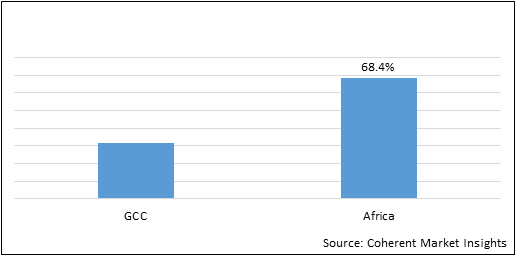Market Overview
A power tool is a tool operated by an additional power source and mechanism other than solely manual labor similar to hand tools. There are several types of power tools based on the source of power such as electric power operated tools, liquid fuel gas-powered tools, pneumatic power tools, powder-actuated tools, and hydraulic tools. As compared to conventional hand tools, power tools are far more sophisticated, efficient, and easier to use. These tools are used in complex and heavy-duty activities where precision and speed are necessary. Power tools find applications in routing, sanding, cutting, drilling, polishing, heating, painting, etc.
The Africa power tools market is estimated to account for US$ 7322.2 Mn in terms of value by the end of 2027.
Market Dynamics- Drivers
Significant increase in investments in housing sector has led to increase in demand for power and hand tools. Sales of power tools have significantly increased across the globe including North America, owing to rising housing investments. Moreover, the demand for restoration in Japan has increased after the Great East Japan Earthquake, which in turn, is expected to drive growth of the Africa power tools market in the near future.
Urbanization in African countries is on the rise with additional infrastructure development such as transportation, energy, and related maintenance services. All these services require hand and power tools. According to the United Nations (UN), the world population is expected to increase by 20% between 2015 and 2025, with Asia and Africa projected to contribute significantly to this growth, this is expected to further urbanization and the subsequent need for hand and power tool. Thus, these factors are expected to propel Africa power tools market growth in the near future.
Statistics:
Africa held dominant position in the Africa power tools market in 2019, accounting for 68.4% share in terms of value, followed by GCC.
Figure 1: Africa Power Tools Market Share (%), in terms of Value, By Country, 2019

To learn more about this report, Download Free Sample
Market Dynamics- Restraints
Constant competition among tool manufacturers is adversely affecting growth of the market. The imported steel prices are falling can be witnessed from the declining imports and rapid growth in the number of unfair trade complaints filed in the U.S. during 2014. Moreover, increased cost of nickel, mercury, and cadmium battery substitutes have resulted in reduced sales of cordless power tools. Thus, these factors are expected to hamper growth of the market in the near future.
Presence of imported tools from China is major threat to regional players. -part exports from China increased substantially between 2000 and 2010, largely due to Chinese Central and Local governments heavily subsidized the country’s auto-parts industry. Thus, these factors are expected to hinder the Africa power tools market growth over the forecast period.
Market Opportunities
Increasing popularity cordless electric saws, sanders, grinders, and polishers have led to increase in demand for power tools thereby surpassing hand tools. Rising consumer shift towards DIY products is another factor boosting the demand for power tools. For instance, the Bosch Power Tools division witnessed a 25% growth in sales of power tools from 2008 to 2012 and is expected to register 18–20% growth by 2015 end. Major companies in the market can capitalize on the opportunities and gain a competitive edge.
Improving living standards and rapid urbanization in emerging economies in African region has led to growth of the DIY segment. Increasing awareness amongst consumers in developing economies is paving the way for DIY tools in numerous applications such as non-vehicular products and services. Moreover, DIY segment is highly popular in emerging economies where home improvement is widely pursued as an enjoyable pastime.
Figure 2: Africa Power Tools Market Value (US$ Mn), 2017 - 2027

To learn more about this report, Download Free Sample
The Africa power tools market was valued at US$ 4465.5Mn in 2019 and is forecast to reach a value of US$ 7322.2 Mn by 2027 at a CAGR of 6.3% between 2020 and 2027.
Market Trends
In the professional segment, expensive powers have witnessed higher penetration with professionals willing to pay more for advanced tools. To a large extent, demand for power and hand tools by professionals has increased as a result of new housing construction projects, household renovations, public investment, and private investments. By 2025, the volume of construction is expected to grow by 70% to reach US$ 15 Trn worldwide. Meteoric growth is likely to be concentrated in three countries namely China, the U.S., and India, with these countries accounting for approximately 60% of the Africa growth.
Many companies in the market are focused on research and development activities of new products, processes, and methodologies, in order to enhance tool strength, durability, and other ergonomic factors. Development of Lithium-ion battery technology is proving to be a major breakthrough. For instance, Hitachi Koki Co. Ltd introduced the series 36V cordless gardening tools along with highly energy-efficient brushless motors.
Competitive Section
Key companies involved in the Africa power tools market are Stanley Black & Decker, Inc., SKF, Atlas Copco AB, Hitachi Koki Co. Ltd, Robert Bosch GmbH, Snap-on Incorporated, Techtronic Industries Company Limited, Makita Corporation, and Danaher Corporation.
Key Developments
Share
Share
Missing comfort of reading report in your local language? Find your preferred language :
Transform your Strategy with Exclusive Trending Reports :
Frequently Asked Questions
Select a License Type
Joining thousands of companies around the world committed to making the Excellent Business Solutions.
View All Our Clients